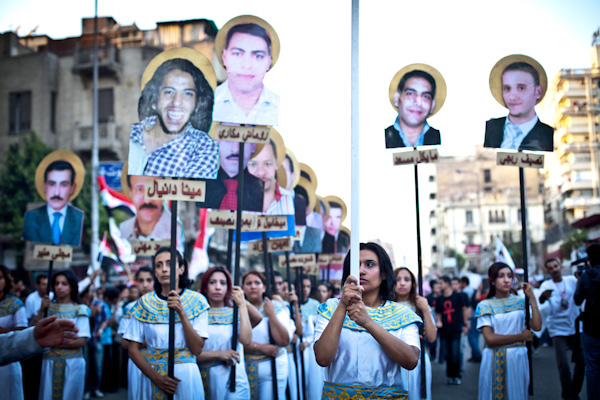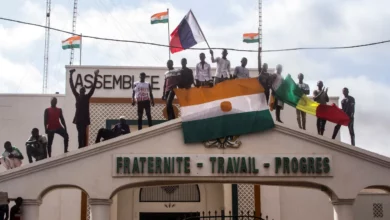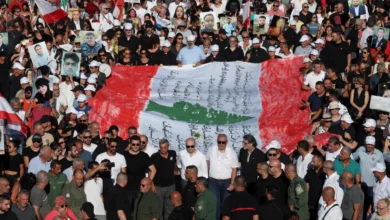
Among the mourners and the angry at the march commemorating the first anniversary of the Maspero massacre, there was an earnest young man brandishing a sign that read, “Egyptian revolution supports Mitt Romney.”
It was an oddly incongruent forum for this declaration, this sudden injection of the outside, and the now, into the memory being revived at Shubra, where thousands gathered just as they had a year ago. But then the memory was being challenged in every way: numbers (smaller), weather (hotter), the time march started (later), messages on placards (completely different).
Images from the 2011 march — the good and the bad — are so seared into my memory that to see it “recreated” Tuesday was strange, a film redone with new actors. At every step I remembered the old: the woman waving the cross at protesters as they prepared to set off; the two men sitting in the boot of a car, who laughed and smiled for the camera; the hymns in Galaa Street, the moment the hymns stopped.
I remember the 2011 march as having more Christian iconography than Tuesday’s, which — of course — was dominated by images of the 28 men killed, especially that of Mina Daniel, whose many friends have ensured that he has not been forgotten. There were also plenty of nooses around pictures of ex-Field Marshal Hussein Tantawi and his friends, and, in a new twist, anti-Muslim Brotherhood proclamations.
Approaching the Ahmed Helmy Tunnel, where last year protesters were pelted with rocks by unknown assailants, protesters demanded that the march stop and regroup, that it take a deep breath and move forward en masse. It did, and a chant of “The people want the execution of the field marshal” rattled around in the tunnel. Last year, the demand had been limited to “The people want the removal of the field marshal” — but that was before the unimaginable happened.
It had been a popular fallacy among some that the army would act as the Coptic minority’s protector against Egypt’s Islamic currents. And then churches were destroyed, and Copts driven out of their homes on Tantawi’s watch. During Tuesday’s march, furious young men burned crude effigies of military council members — army uniforms stuffed with paper and topped with a cardboard cutout of the unfortunate men.
The legacy and legend of the Egyptian military is just one of the myths that have been challenged by the 25 January revolution. Egyptian citizens have discovered that Egyptian soldiers will kill Egyptian citizens, and that at times the “one hand” slogan used to describe Christian and Muslim unity conjures up a pummeling fist, such as when individuals were attacked or arrested by groups of citizens on the night of 9 October, because they were called Peter or because they were wearing a cross.
The real horror of Maspero was that it exploded so many myths at once in this almost dreamlike frenzy of violence: religious harmony, army gallantry … A boil was lanced, and the pus erupted, but the wound was never given air to heal. It was covered up, and left to fester, as is generally the way.
The physical blood and the debris had been removed from the (crime) scene by the next morning.
A group of protesters and unlucky Christian passers-by were arrested and punished twice. The first time was in a room on Maspero’s ground floor, with army boots and batons, and one wonders what the cleaners made of the aftermath when they arrived the next morning. The second time, the cruelty disguised itself in legal process and involved zany charges (including against Mina Daniel) and judicial sophistry that subjected these men to three months as part of an attempt to repackage events.
When Vivian Magdy grasped the hand of her dead fiancee in a morgue in Cairo, surrounded by the blood and guts of other dead men shot or crushed to death, and screamed with grief, it was difficult to imagine that nobody would be held accountable for their killing. But a military court earlier this year found three junior soldiers guilty of “manslaughter” for their role in driving the armed personnel carriers that killed 15 people, and handed them brief prison sentences.
The trial was essentially an exercise in pummeling the truth until it resembled something more palatable. The military line was that the soldiers panicked when confronted by thousands of protesters descending on them, and drove into the crowd while trying to escape.
I had never seen people be killed before Maspero. Maybe that is why I am regularly visited by the image of the APC that climbed over an island in the middle of the road and crushed the people in its path, of the way it slowly and serenely went up the October Bridge, while below it another APC circled under the same bridge and returned to the protest driving in a strange, zigzag fashion at a high speed, competently plowing into anything in its path. Panic-free.
Maspero was a thousand myths short-circuiting. State apparatus, notably the media, managed to contain the damage, but truth can be annoyingly persistent, even when it is just presented in the form of cardboard cutouts of the faces of 28 dead men and a chant, fel ganna … ya Mina. In heaven, Mina.




